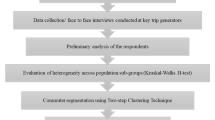Abstract
The perceived travel time is one of the important trip characteristics used in the field of travel behavior research. This study analyses the socio-economic and the trip characteristics influencing the travel time perception of the cyclists in a residential academic campus. Two approaches were used to gather the relevant information from the daily commuting cyclists. First, the actual travel time was collected by manually noting down the starting and ending times of the trip as well as using the smartphone sensors. Second, a questionnaire survey was administered to obtain the perceived travel time, other travel parameters, socio-economic, and behavioral characteristics of the trip maker. Using the actual and the revealed data, the present study has evaluated the perception error ratio (PER) and the difference in the perceived and actual travel times, and classified the over and under perceived trip makers. Then the factors influencing the perception error of cyclists were identified. Model results revealed that the use of PER misclassifies the over and under perceived trip makers. Actual travel time and the income level were found to influence the perception error corresponding to both the under and over perceptions. It was also found that the activities of the trip maker, during the trip have a significant influence on the trip makers’ perception.



Similar content being viewed by others
References
Parthasarathi P, Levinson D, Hochmair H (2013) Network structure and travel time perception. PLoS ONE 8(10):e77718
Delclòs-Alió X, Marquet O, Miralles-Guasch C (2017) Keeping track of time: a smartphone-based analysis of travel time perception in a suburban environment. Travel Behav Soc 9:1–9
Clark JE (1982) Modeling travelers’ perceptions of travel time. Transp Res Rec 890:7–11
González RM, Martínez-Budría E, Díaz-Hernández JJ, Esquivel A (2015) Explanatory factors of distorted perceptions of travel time in tram. Transp Res F Traffic Psychol Behav 30:107–114
Indian Institute of Technology Guwahati, Assam, India. http://www.iitg.ac.in. Accessed 10 July 2018
Sims D, Matthews SA, Bopp MJ, Rovniak LS, Poole E (2018) Predicting discordance between perceived and estimated walk and bike times among university faculty, staff, and students. Transportmetrica A Transp Sci 14(8):691–705
Peer S, Knockaert J, Koster P, Verhoef ET (2014) Over-reporting vs. overreacting: commuters’ perceptions of travel times. Transport Res Part A Policy Pract 69:476–494
Zhu X, Li Q, Chen . (2013) APT: accurate outdoor pedestrian tracking with smartphones. In: INFOCOM, 2013 Proceedings IEEE, pp 2508–2516
Manzoni V, Maniloff D, Kloeckl K, Ratti C (2010) Transportation mode identification and real-time CO2 emission estimation using smartphones. In: SENSEable City Lab, Massachusetts Institute of Technology
Abdulazim T, Abdelgawad H, Habib K, Abdulhai B (2013) Using smartphones and sensor technologies to automate collection of travel data. Transp Rese Rec J Transp Res Board 2383:44–52
Wolf J (2006) Applications of new technologies in travel surveys. In: Travel survey methods: quality and future directions. Emerald Group Publishing Limited, pp 531–544
Wang Z, He SY, Leung Y (2018) Applying mobile phone data to travel behaviour research: a literature review. Travel Behav Soc 11:141–155
Martens K (2004) The bicycle as a feedering mode: experiences from three European countries. Transp Res Part D Transp Environ 9(4):281–294
World Bank Help Desk for economies of different countries. https://datahelpdesk.worldbank.org/knowledgebase/articles/378834-how-does-the-world-bank-classify-countries. Accessed 5 July 2018
Houston D, Luong TT, Boarnet MG (2014) Tracking daily travel; Assessing discrepancies between GPS-derived and self-reported travel patterns. Transp Res Part C Emerg Technol 48:97–108
Kockelman KM, Kalmanje S (2005) Credit-based congestion pricing: a policy proposal and the public’s response. Transp Res Part A Policy Pract 39(7–9):671–690
Author information
Authors and Affiliations
Corresponding author
Additional information
Publisher's Note
Springer Nature remains neutral with regard to jurisdictional claims in published maps and institutional affiliations.
Rights and permissions
About this article
Cite this article
Anna, V.A.B.K., Chunchu, M. & Tamarapalli, V. Socio-economic and Trip Characteristics Influencing the Travel Time Perception of Cyclists: A Case Study of a Residential Academic Campus. Transp. in Dev. Econ. 8, 7 (2022). https://doi.org/10.1007/s40890-021-00144-1
Received:
Accepted:
Published:
DOI: https://doi.org/10.1007/s40890-021-00144-1




